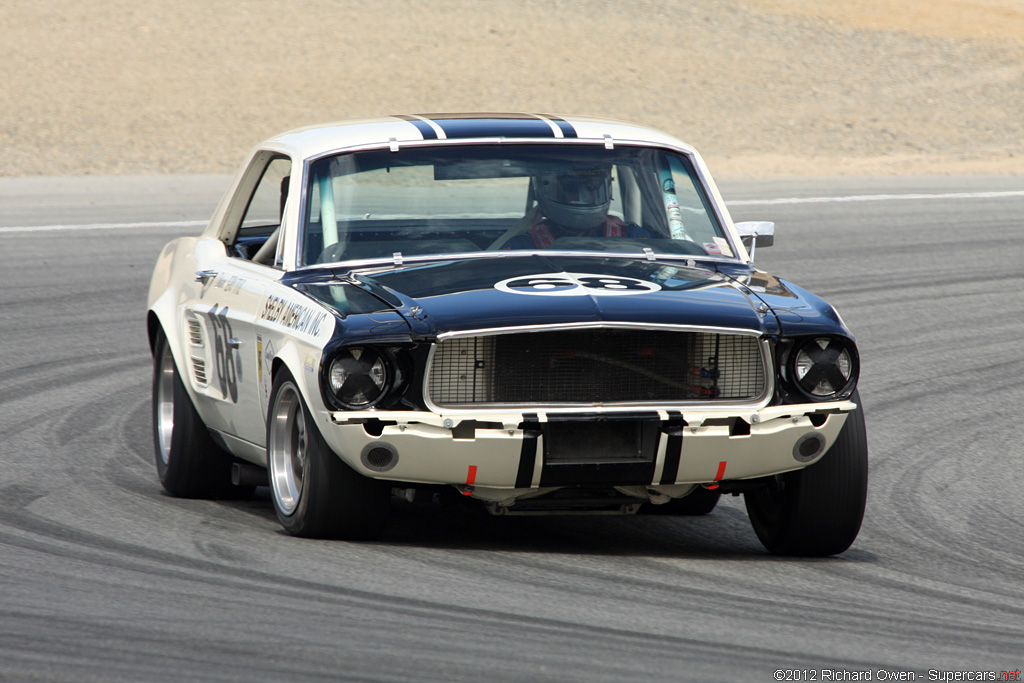| Group 2 Racing 1966 | Group 2 Racing 1968 | Group 2 Gallery | |||
| Group 2 Racing 1967 | Trans-AM Racing 1969 |
After winning the Manufacturers Trophy in 1966 & 1967, the Ford team had some stronger competition for 1968. Chevrolet was about to get involved in a very big way. Vince Piggins at Chevrolet saw the great potential for sales of Camaros by racing in the Trans Am series. He committed to SCCA that Chevrolet would support the series.
Piggins personally took charge of the Z-28 project. The first Z-28s were powered with the proven 283 cid. Chevy’s production engine was a 327, but it exceed the maximum displacement allowed at 305 cid. Piggins came up with the idea of putting a 283 crank in a 327 block. The resulting 4×3 bore and stoke yielded 302.4 cid, a 13 cid advantage over the Ford 289, as much as 25 horse power. It took more than cubic inches to beat the experienced Ford team. Penske was enlisted to champion the Z-28 Camaros. The Z-28s won the last two races of the 67 season.
The 302 Camaros had a clear horse power advantage over the Mustangs. The ports and valves in the 289 heads were too small to produce the horsepower needed. The best head available was the hipo heads with small valves and ports. The new Ford 302 would be ideal for Trans-Am racing since it under the 305 cid limit of class limit, but the hipo heads would be even more restrictive on the longer stoke of the 302. Ford started a crash development program to fix the problem at Ford Engine and Development during 1967. This effort would lead to development of the Boss 302 in 1969. It was also during this development time that the famous Ford “tunnel port head” came about. There was a pull out the stops effort to maximize the flow of the heads. The Ford engineers developed a brand new head with straight intake ports and the pushrod tubes running through the port. In the past the ports would twist around the pushrods. The intake valves were a huge 2.12″ compared to 1.77″ for the 289. The exhaust valves were 1.54″ versus 1.44″. Each port feed an individual cylinder. These heads became known as “tunnel ports.” On paper this combination of the head design with the new 4 bolt main 302, looked unbeatable.
Ford dropped the “Terlingua Racing Team” image and provided full support to the Shelby Racing Company. Two Group 2 Mustangs were built for the Shelby team.
The first Trans-Am race was the Daytona 24 hour endurance race. This was the first time that the Trans-Am cars were included in the primary event. Trans-Am races were held prior to the main endurance races in 1967. The Mustangs dominated the Group 2 race. Jerry Titus and Ronnie Bucknam 64 laps ahead of the nearest Group 2 car, Donohue’s Penske Camaro. In fact, the Titus/Bucknam Mustang finished third overall just behind three Porsche 907 prototypes. It was a great showing for Ford, the Shelby Team and the Trans-Am cars. Half of the 30 cars that finished the race were Trans-Am cars. But Daytona wasn’t the beginning of Ford’s 1968 success, it was the end.
You have to finish races to win them, though. The tunnel port engines just didn’t have lasting power. Engine failure after engine failure keep the Mustangs from finishing the races. Penske’s Camaros dominated the 1968 Trans-Am racing. Mark Donahue, driving a Z-28 won eight consecutive Trans-Am races, beginning with the second race, the 12 Hours of Sebring late in March 1968. Donahue actually won a total of 10 out of 13 races in the series. As for the Shelby’s team, the only races they won were the 24 Hours of Daytona in February, 1968, and Horst Kwech won at Riverside in car #17 in the next to last race of the season. The Manufacturers Trophy was already sowed up by Chevrolet.
The eventual blame for the Mustang’s poor showing was the laid on the “tunnel port” engines. The engine has a bad oiling problem at the top end of the rpms. Many engine came apart during the season. The Shelby Team even asked Ford to let them go back to the tried 289’s but Ford wanted the 302’s to win. Which they didn’t. The “tunnel port” quickly faded away after the 1968 season. The Donohue Camaro was awesome on the track. The Penske team got more horsepower from the Chevy 302 then the Mustangs and flat outran them. As the season matured so did the Camaro team. But with the Ford team’s bad luck, it didn’t take much effort to win the season. Chevrolet finished the season with 105 points to Ford’s 63.
Before the ’68 season was over, Ford was already working on a new block design, the 351, for the 1970 production runs. The 351 heads had huge canted intake and exhaust valves and ports. Someone decided to try those heads on the 302 block. With some slight modifications to water passages, the heads fit on the tunnel port block.
During 1968 SCCA opened up some of the rules. The cars could have floating rear ends, four wheel disc brakes and wider tires. Wheel and fender flares could be added to accommodate the eight inch tries. Fuels cells were mandatory.
